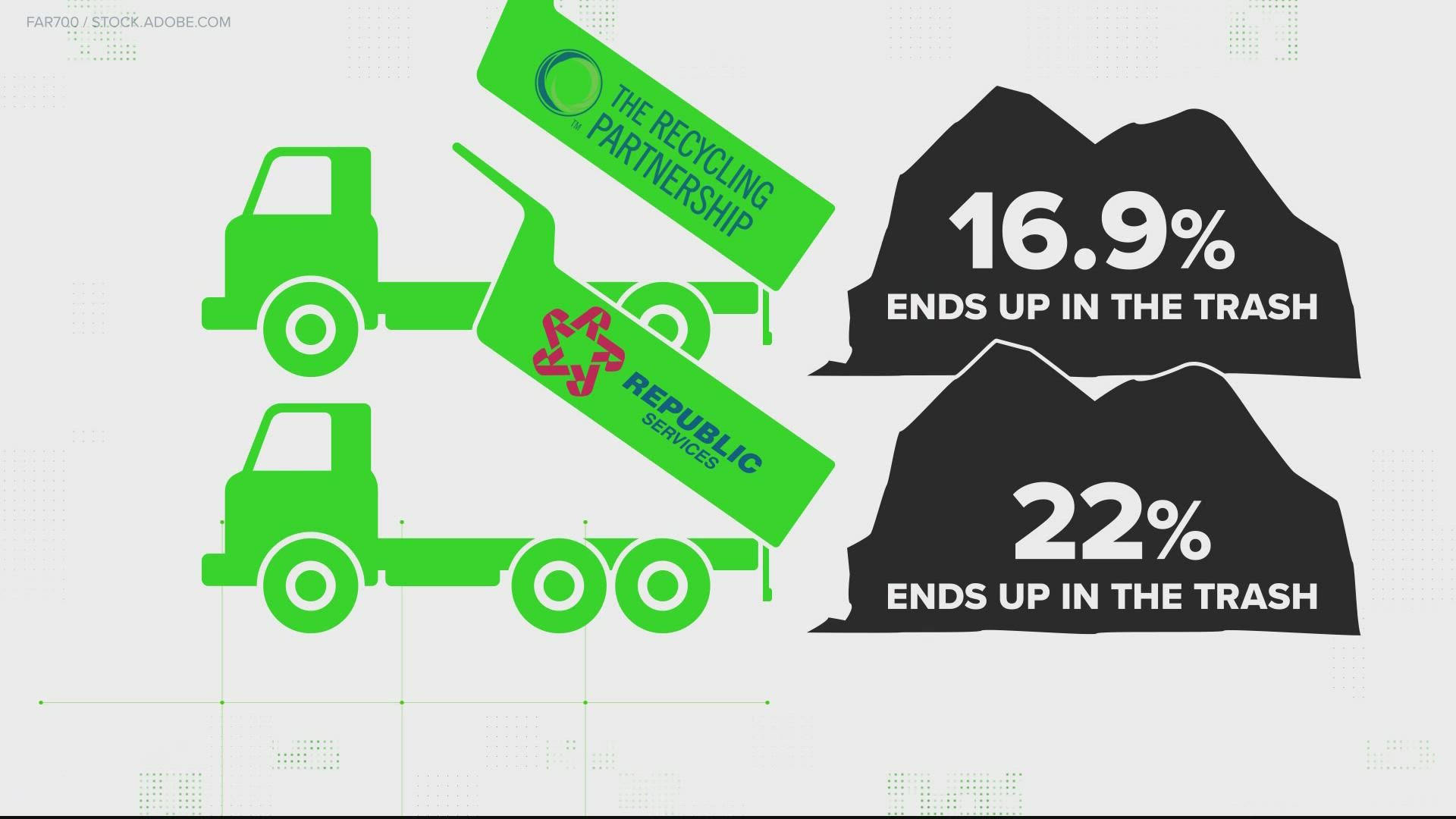PRINCE WILLIAM COUNTY, Va. — As the severe effects of climate change increase in frequency, lots of us are searching for what we can to make even the smallest difference in the health of our planet. For decades, we’ve been told that recycling is one of the easiest things you can do to make a positive impact.
But as devastating storms worsen, and global leaders seemingly do nothing, young people have increasingly higher rates of climate doom-ism—the "none of what we do matters" sentiment is a pretty common theme on social media.
Take this tweet with hundreds of thousands of likes and retweets: “Did it hurt? when you realized you’ve been recycling for years and 79% of it still ends up in a landfill.”
We're breaking down why that tweet is misleading.
THE QUESTION
Does 79% of what you recycle end up in a landfill?
THE SOURCES
- Debbie Spiliotopoulos, Senior Environmental Planner for the Northern Virginia Waste Management Board
- Scott MacDonald, Recycling Programs Manager for Prince William County
- Jake Anderson, General Manager of the Republic Services recycling processing facility in Manassas, Va.
- Rob Taylor, Director of Community Grants and Development for the non-profit , Recycling Partnership
THE ANSWER
No, 79% of your recycling does not end up in a landfill. This highest estimate for how much recycling ends up in the trash was a third. The lowest was 15% in Northern Virginia.
WHAT WE FOUND
Recycling, like everything else in the United States, is driven by profit incentives. Recycling processors make their money by correctly processing as many recyclable materials as possible and selling them to companies that can turn those materials into something new. Tons of bales of aluminum cans or cardboard or plastic bottles leave the facilities in droves every day to be broken down and reused.
The money comes from how many perfect bales are shipped out. But trash bales leaving a recycling facility means inefficient business and a lower profit, according to Anderson, the General Manager of the Republic Services recycling facility in Manassas, Va.
“We make money off of the material that we process. We employ people whose job it is to stand in front of conveyor belts and pick out the garbage from the recycling,” Anderson said. “Things entering our system, like trash, [do] not help.”
Recycling trucks pick up whatever you put in the bin and bring it to Anderson’s facility, dropping off mostly recyclables, but often containing trash as well—things like batteries, diapers and plastic bags. It all makes its way through the massive processing plant, where a combination of workers and machines split up what belongs and what doesn’t.
Anderson told us that about 15% of what enters his facility in Prince William County, Va. ends up getting sent out as trash. A majority of the time, that ends up in a landfill.
Republic Services has waste processing facilities in 44 states and Washington, D.C. (excluding Alaska, Hawaii, Maine, Nebraska, North Dakota and South Dakota). A spokesperson told us that their company-wide average contamination rate is 22%, meaning 22% of what goes in the recycling bin ends up in a landfill.
The Recycling Partnership is a national nonprofit actively working to provide grants to localities to help them improve their recycling programs. By their count, on average nationwide, 16.9% of what gets put in the recycling bin doesn’t belong there at all and therefore ends up in the trash. On top of that, the Director of Community Grants and Development, Rob Taylor estimated that at least 90% of what’s correctly put in the recycling bin goes where it’s supposed to go.
No one is tracking these rates at a national level, however. Republic Services could only give us estimates from the facilities they own. The Recycling Partnership’s number is an average of only approximately a third of the localities they work with—mostly because very few people are tracking it at all.
In Northern Virginia, specifically, Scott MacDonald, the Recycling Programs Manager for Prince William County, said about a third of what goes in people’s recycling bins is trash. His estimate was based on numbers cited during a March 2021 regional Recycling Markets Subcommittee meeting.
All of our experts said there are a number of factors that drive a localities’ ability to effectively recycle. The first, and most important, is confusion at the very beginning of the process: Your recycling bin.
Every individual locality has different, specific rules for what kinds of items are recyclable. There are no nationwide or statewide standards, and they’re even usually different within counties. You can recycle glass bottles in Washington, D.C. but not in Fairfax County. The only plastic items accepted in Loudoun County are bottles, jugs and jars—no disposable cups or takeout containers.
The second factor that could send your recycling to the landfill is faulty sorting machines. Some programs and facilities are better funded than others, and therefore will have better functioning technology to sort out what belongs in the trash and what doesn’t.
However, to say that all trash leaving the recycling facilities goes to a landfill would not be true. In some parts of the country, a percentage of trash gets sent to Waste to Energy (WTE) plants instead. That’s exactly what it sounds like — a plant that burns up trash and converts it into energy. Debbie Spiliotopoulos told us about 60% of trash in Northern Virginia goes to a WTE plant. Nationwide, that number is just 10%.
Find out what can go in the recycling bin in your area:
Sign up for the Get Up DC newsletter: Your forecast. Your commute. Your news.
Sign up for the Capitol Breach email newsletter, delivering the latest breaking news and a roundup of the investigation into the Capitol Riots on January 6, 2021.

